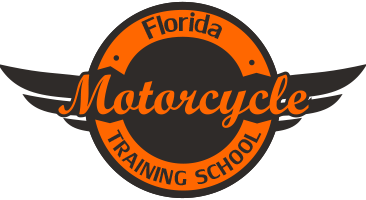The MSF Basic RiderCourse eBRC is required by the FRTP in order to obtain you new Driver License with the “Motorcycle Endorsement”. It is for beginner riders of all ages*, or riders wanting to refresh their skills, or experienced riders needing their Motorcycle Endorsement.
The eBRC consists of:
– 5 hours of classroom-style, guided group-study, followed by a Knowledge Test, and
– 10 hours of RiderCoach instructional riding on our FLMTS private motorcycle range, followed by a Riding Skills Evaluation.
FLMTS has a private, beautiful, paved riding range in Hialeah Gardens, central and easily accessible, in a closed, controlled, motorcycle-training-only environment.
Free of charge, FLMTS provides each rider with a professionally maintained motorcycle and a DOT compliant helmet for use during the eBRCu.
In the classroom, facilitated by our FLMTS professional MSF-certified, FRTP-licensed RiderCoaches, you will learn about various motorcycle types, the primary & other controls for street motorcycles, basic operation, riding protective gear, riding techniques and road surfaces, and how to become a safe and more alert, skilled, responsible motorcyclist.
On the range, the eBRCu trains you on FLMTS ‘street motorcycles’. Our RiderCoaches guide you through basic skills of straight-line riding, stopping, shifting, typical roadway turns, slow-speed tight-turns, weaves, swerves, gradually progressing to emergency stops in a curve and emergency braking.
Here are the 14 Riding Exercises in the 2-day eBRC:
- Motorcycle Familiarization.
- T-CLOCS pre-ride inspection.
- Location and operation of important controls and major parts.
- Mounting/dismounting procedures.
- Elements of good posture.
- Using the Friction Zone.
- Practice using the clutch “friction zone” for control.
- Starting & Stopping Drill.
- Coordinate the friction zone, throttle, and brakes to control the motorcycle.
- Start out and stop with precision and control.
- Shifting & Stopping.
- Shift gears and stop smoothly.
- Basic Skill Practice.
- Low-speed maneuvering skills.
- Throttle use and brake manipulation for corners.
- Pressing to Initiate & Adjust Lean.
- Maneuvering elements needed for negotiating curves.
- Countersteer: Effects of handgrip pressure and handlebar movement to initiate and adjust lean.
- Stopping More Quickly & Tight Turns from a Stop.
- Progressive braking pressure to stop more quickly without skidding.
- Making a sharp turn from a stop.
- Stopping Distance Demonstration.
- Observe demonstration by RiderCoach of the reaction/braking parts of total stopping distance.
- Effects of speed on braking distance.
- Relate the results to intersection strategies.
- Limited-Space Maneuvers.
- Maneuvering skills to allow slow-speed turns in limited spaces.
- Counterweight technique.
- Stopping in a Curve.
- Maintain control while stopping in a curve.
- Traction management.
- Curve Judgment.
- Skills for negotiating multiple curves.
- Learn the “search-setup-smooth” strategy.
- Multiple Curves & Lane Changes.
- Negotiating curves and lane changes.
- Safety margins and gap selection.
- Crossing an Obstacle & Swerving.
- Techniques for crossing over obstacles.
- Execute a basic swerve.
- Turning from a stop.
- Refine slow-speed weaves.
- Skill Practice.
- Riding skills practice, a review combining a variety of maneuvers.
- Riding Skills Test.
- To assess basic skills using a cone weave, normal stop, turning from a stop, U-turn, quick stop, obstacle swerve, and cornering maneuver.
- To demonstrate basic motorcycle control skills and ability to avoid an obstacle.
- To demonstrate ability to use the proper technique to negotiate a curve.
Successful completion of the eBRC requires passing the classroom Knowledge Test (25 multiple choice questions) and Riding Skills Test (5 separate skill-sets are tested). Graduation concludes with your Course Completion Card handed to you by your RiderCoach, signifying a milestone in your own development of safe riding techniques.
Then, two days later and before you ride on public roadways, you need to go to the FLHSMV with the required identification, to obtain your new Florida Driver License with the Motorcycle Endorsement. The shiny-side up and blue skies, open roads and riding buddies, let the serious fun begin!
